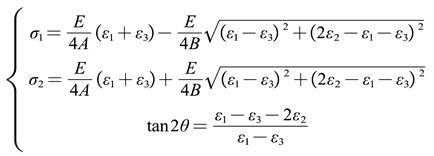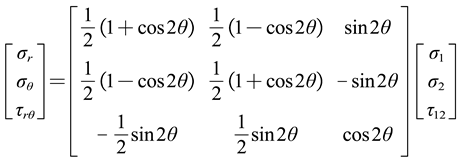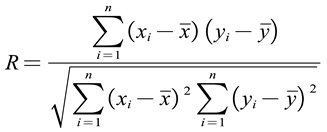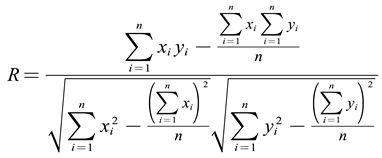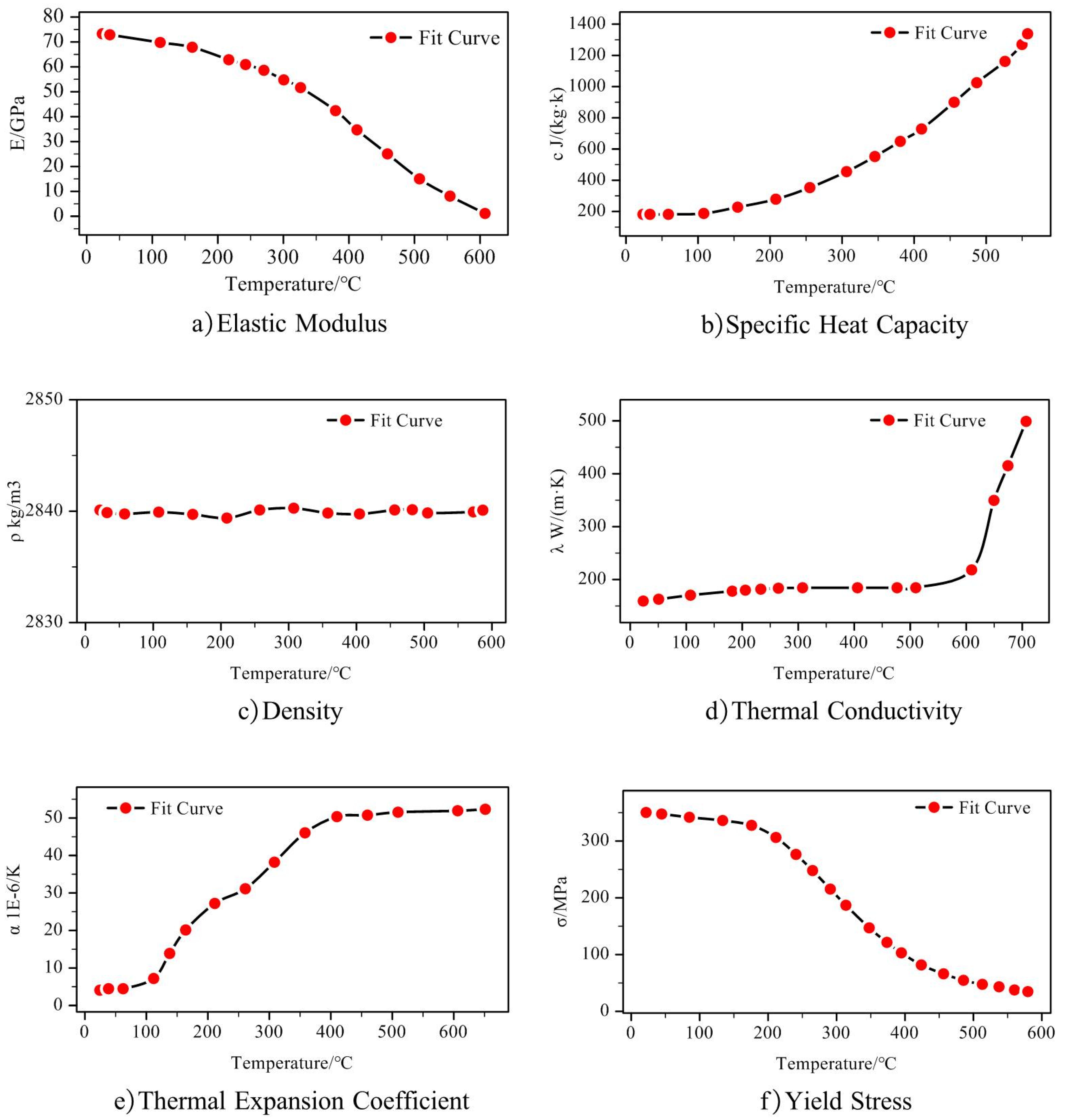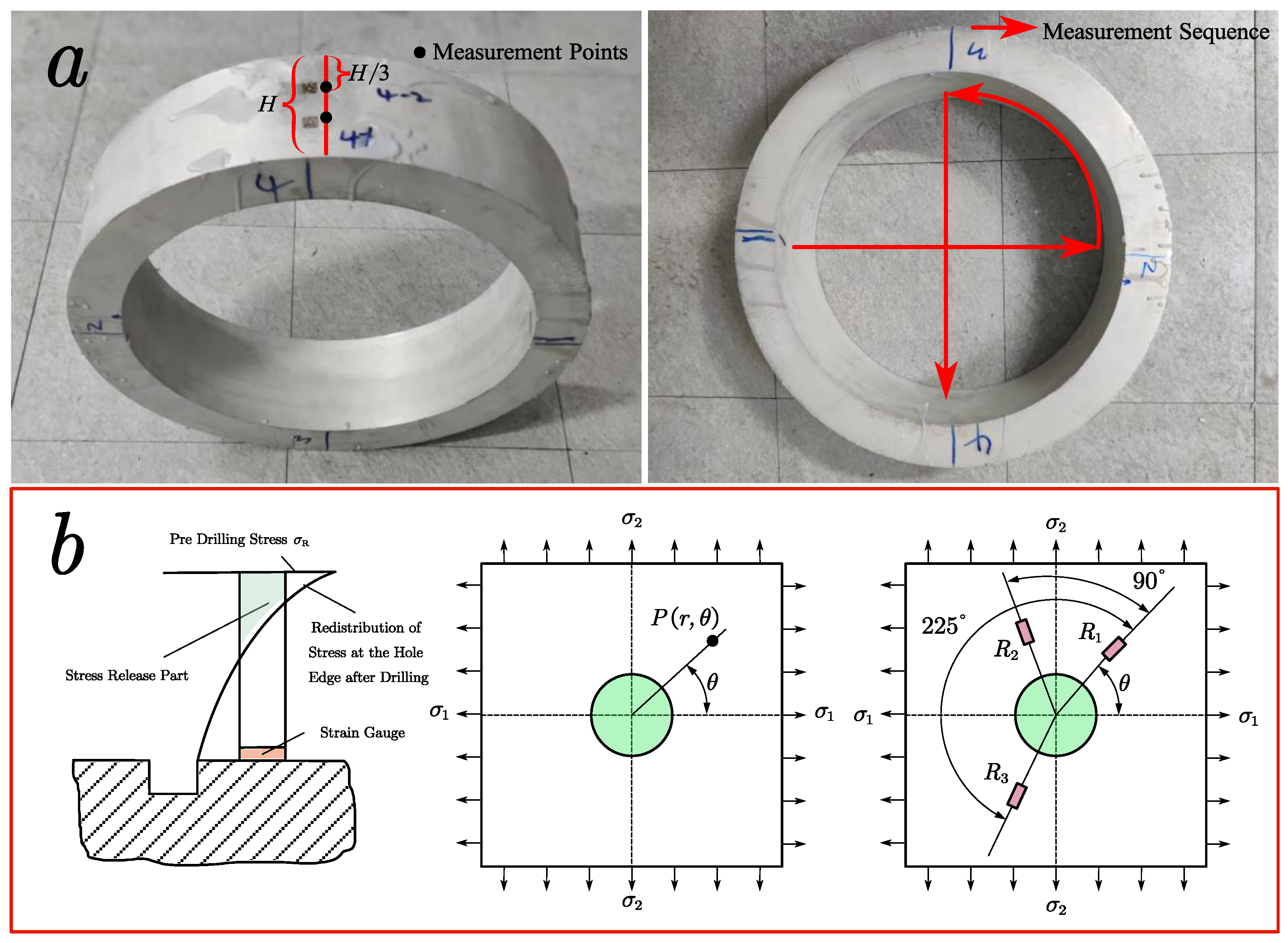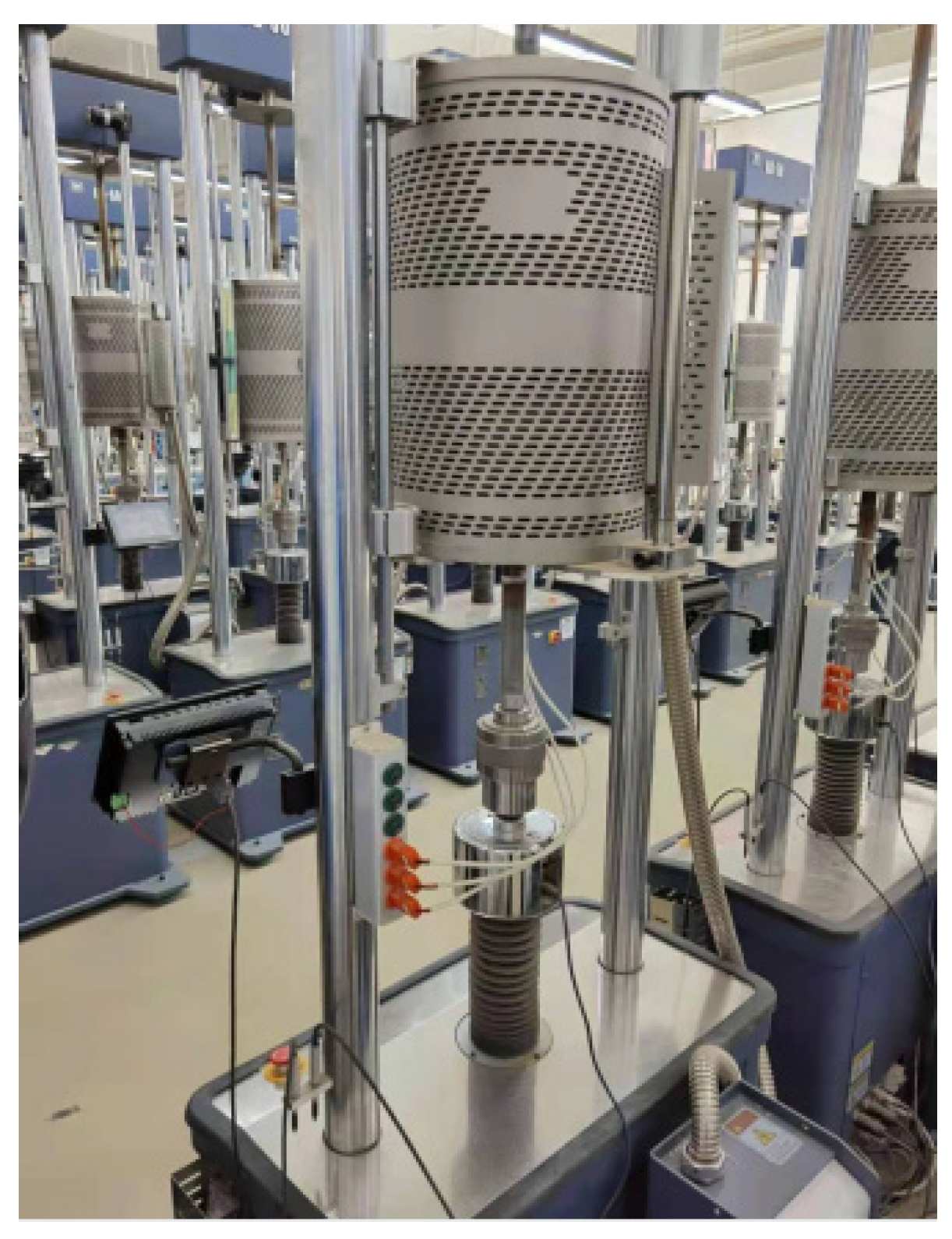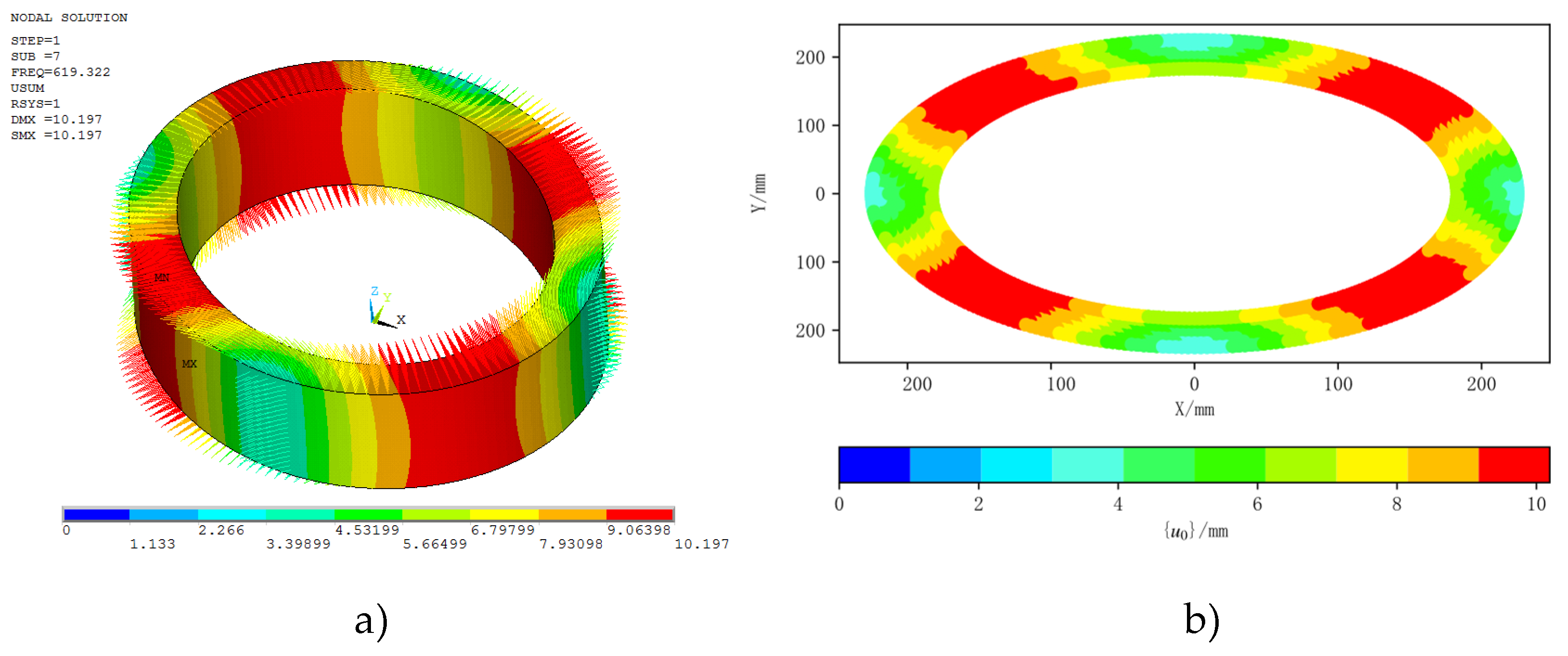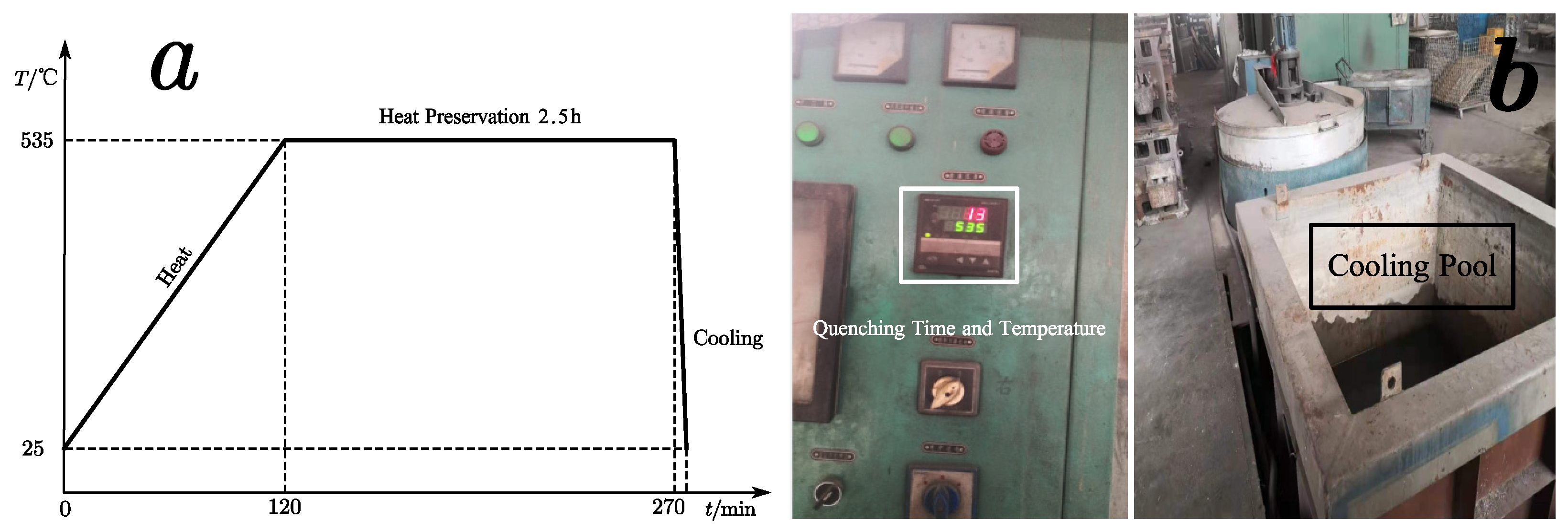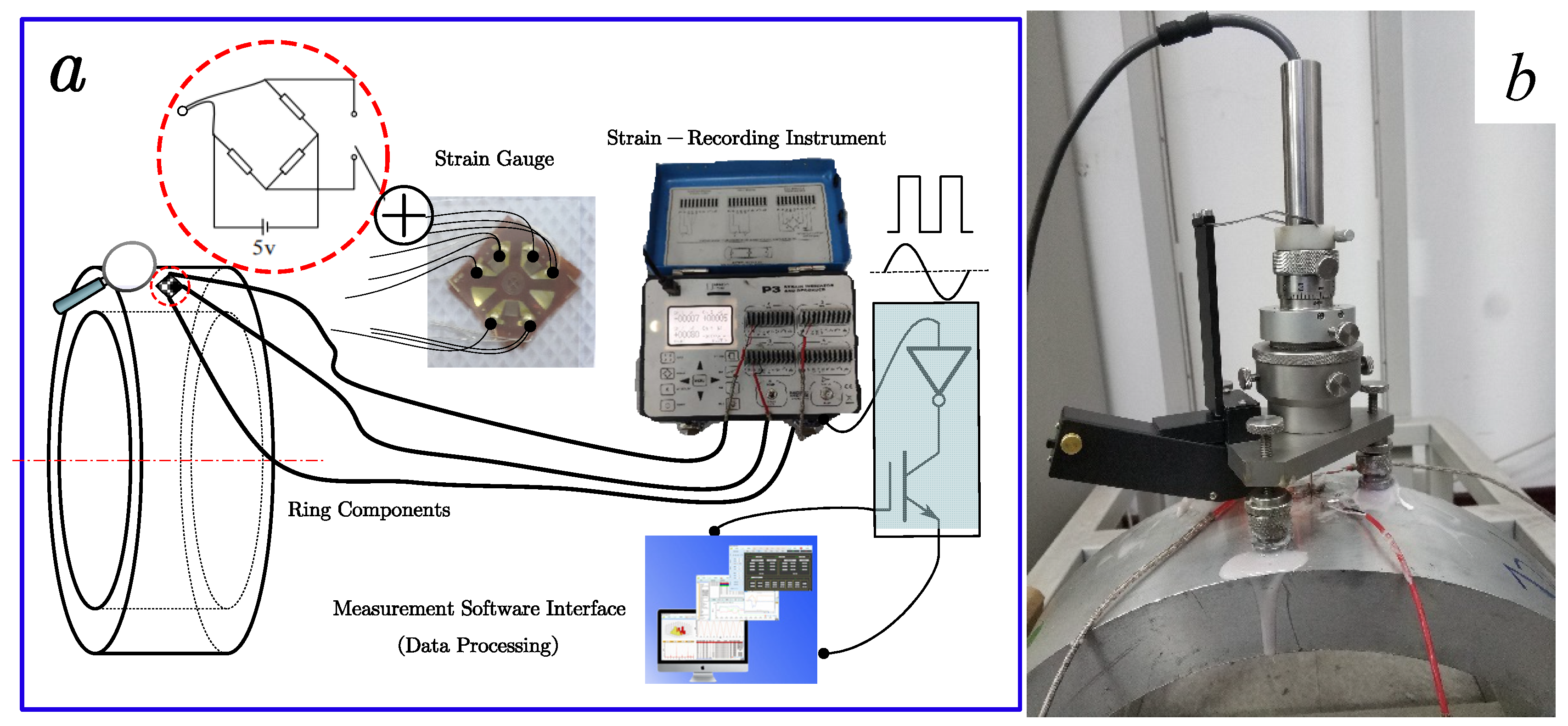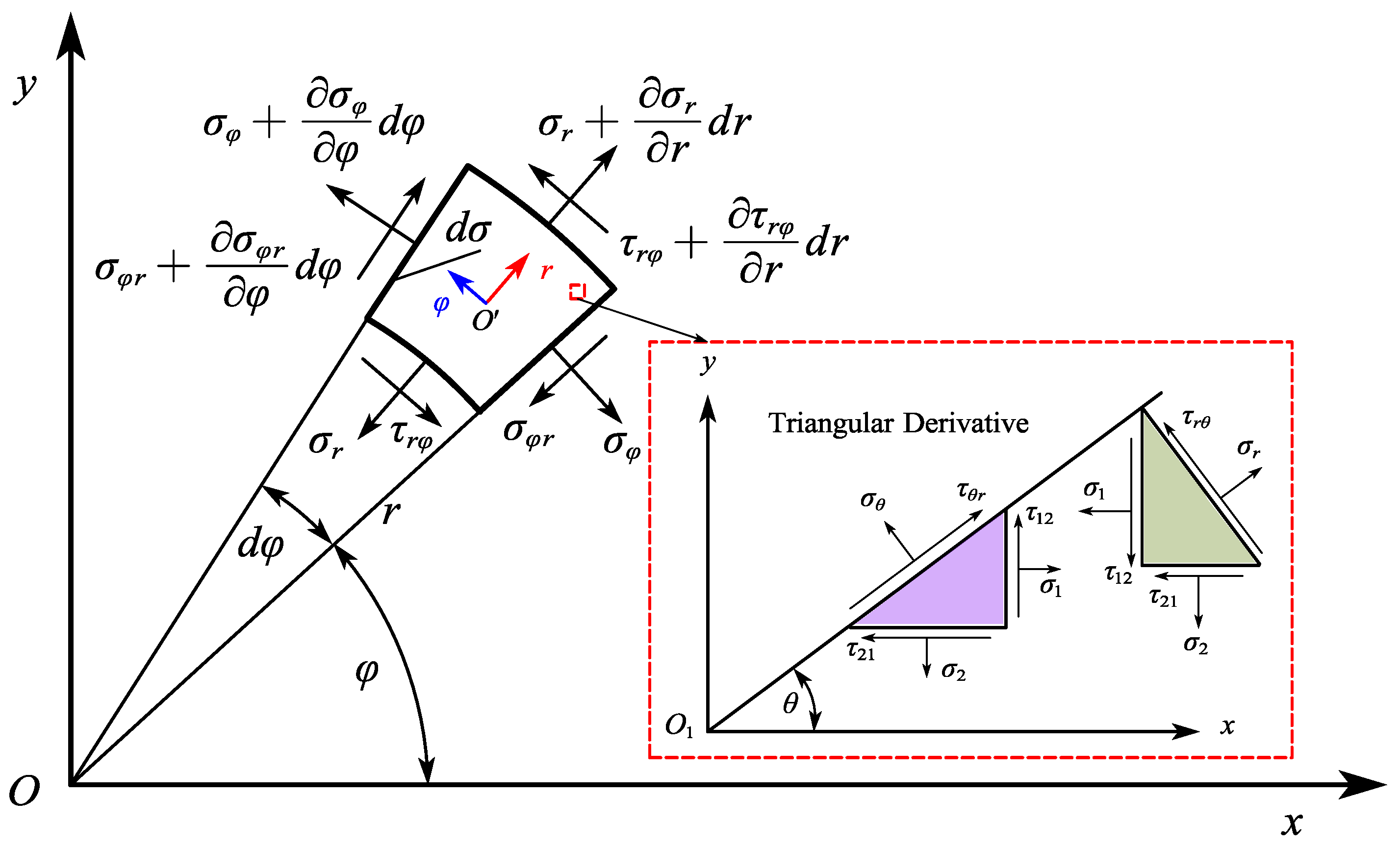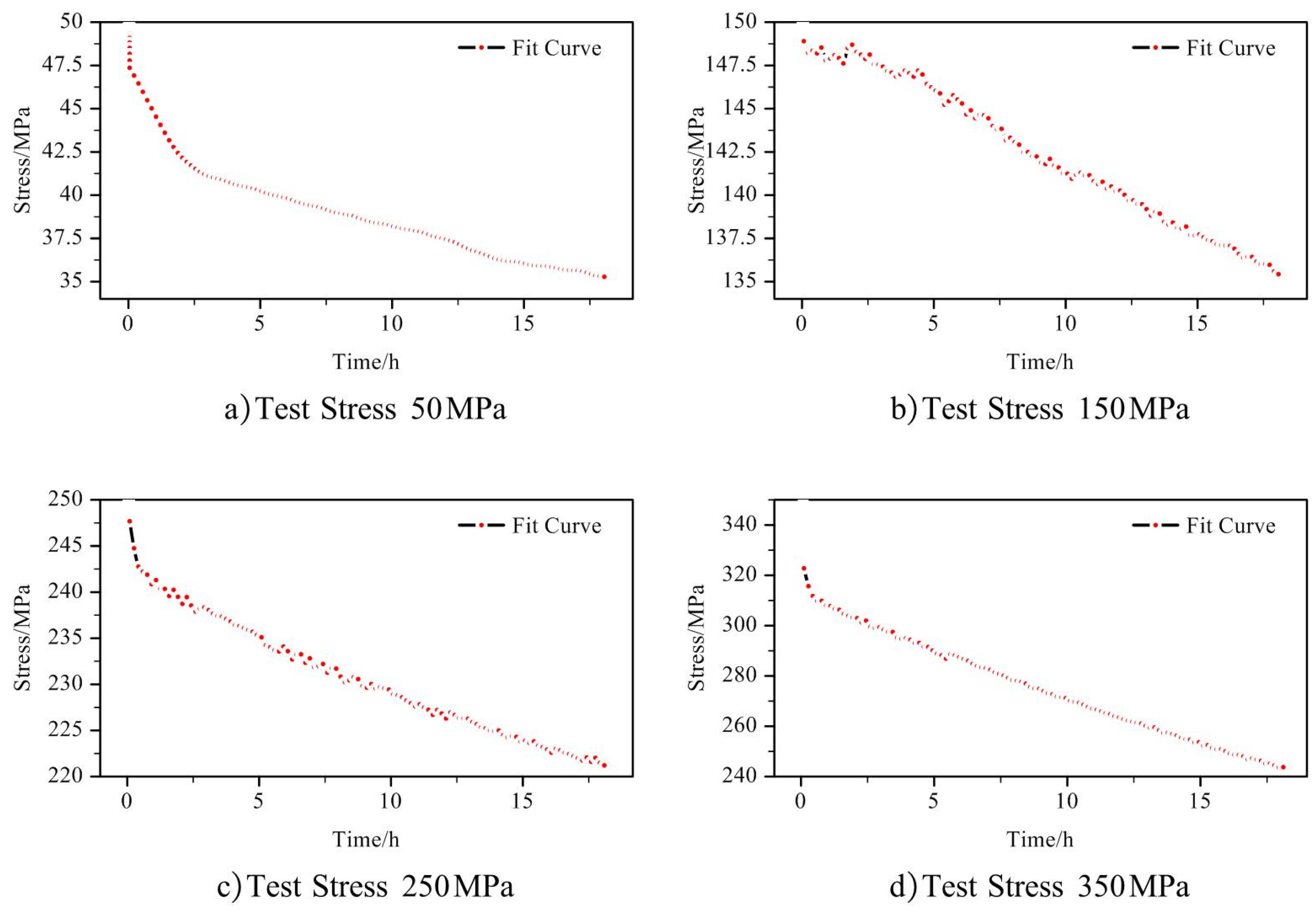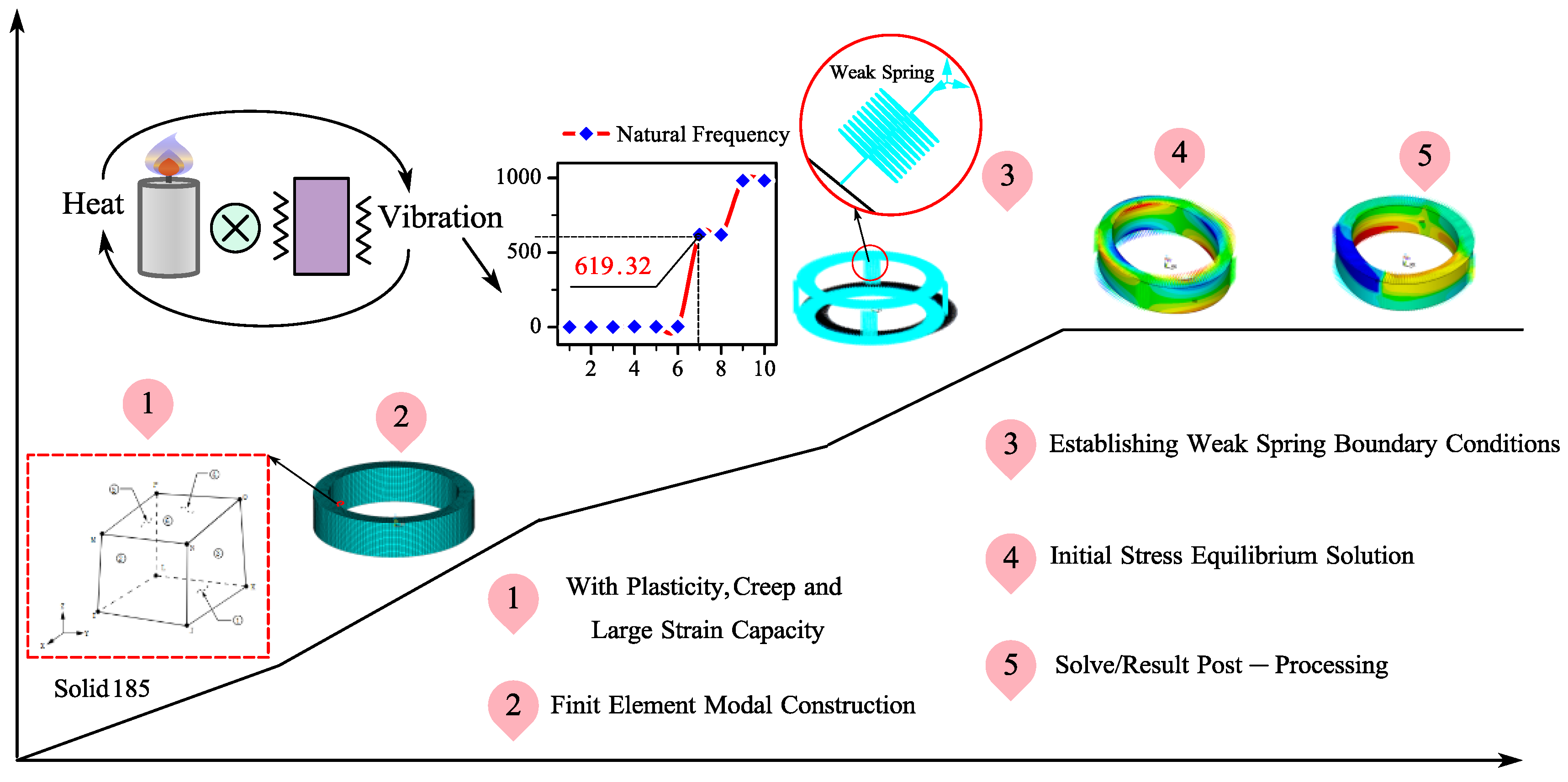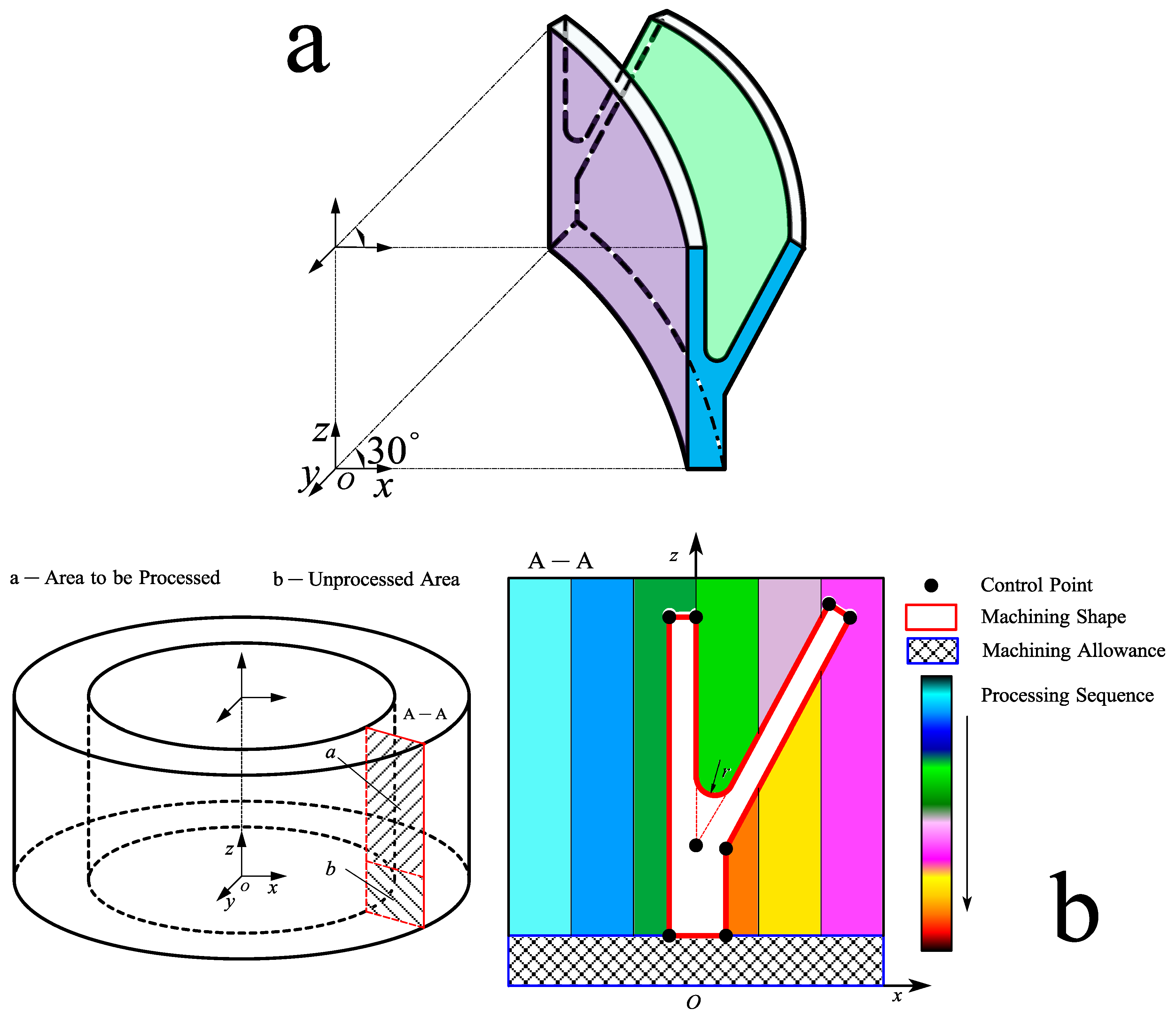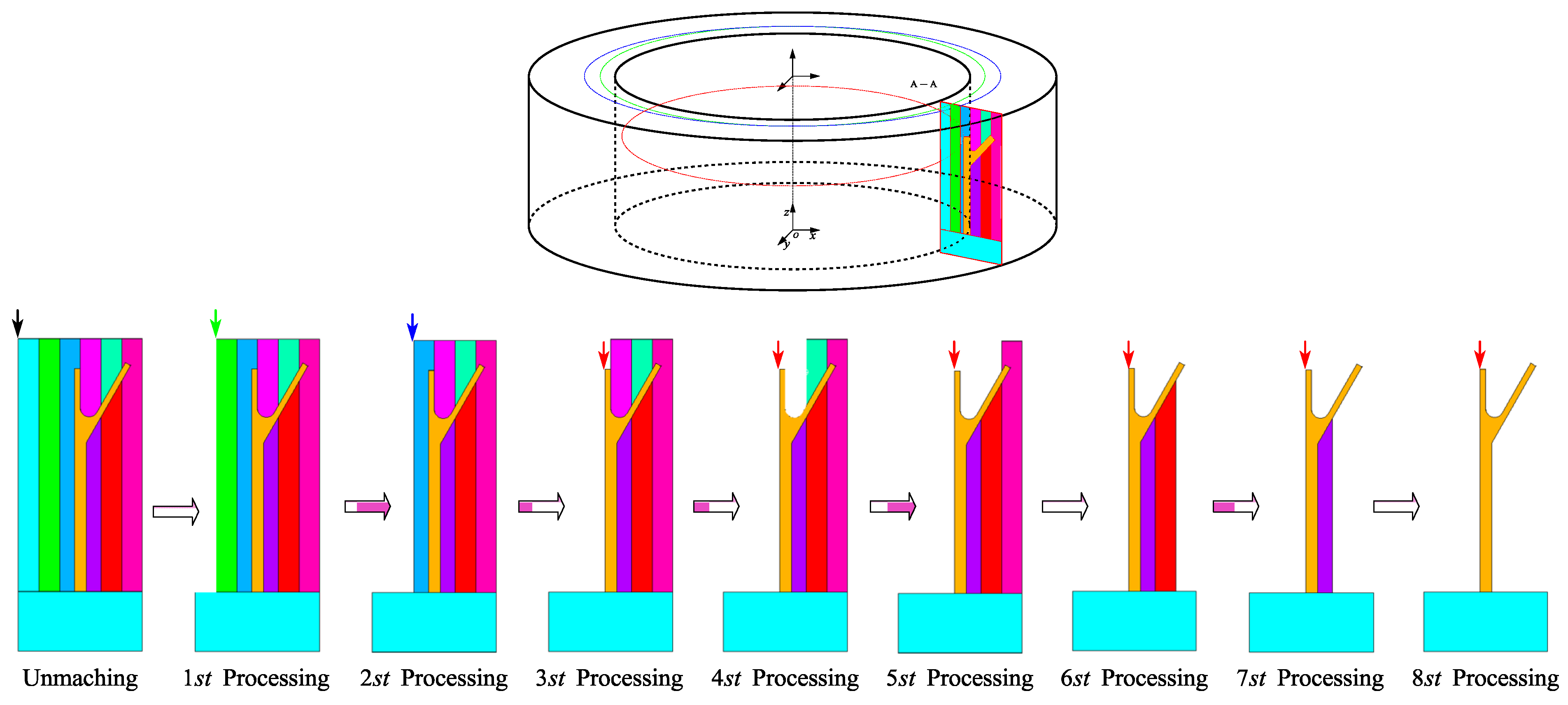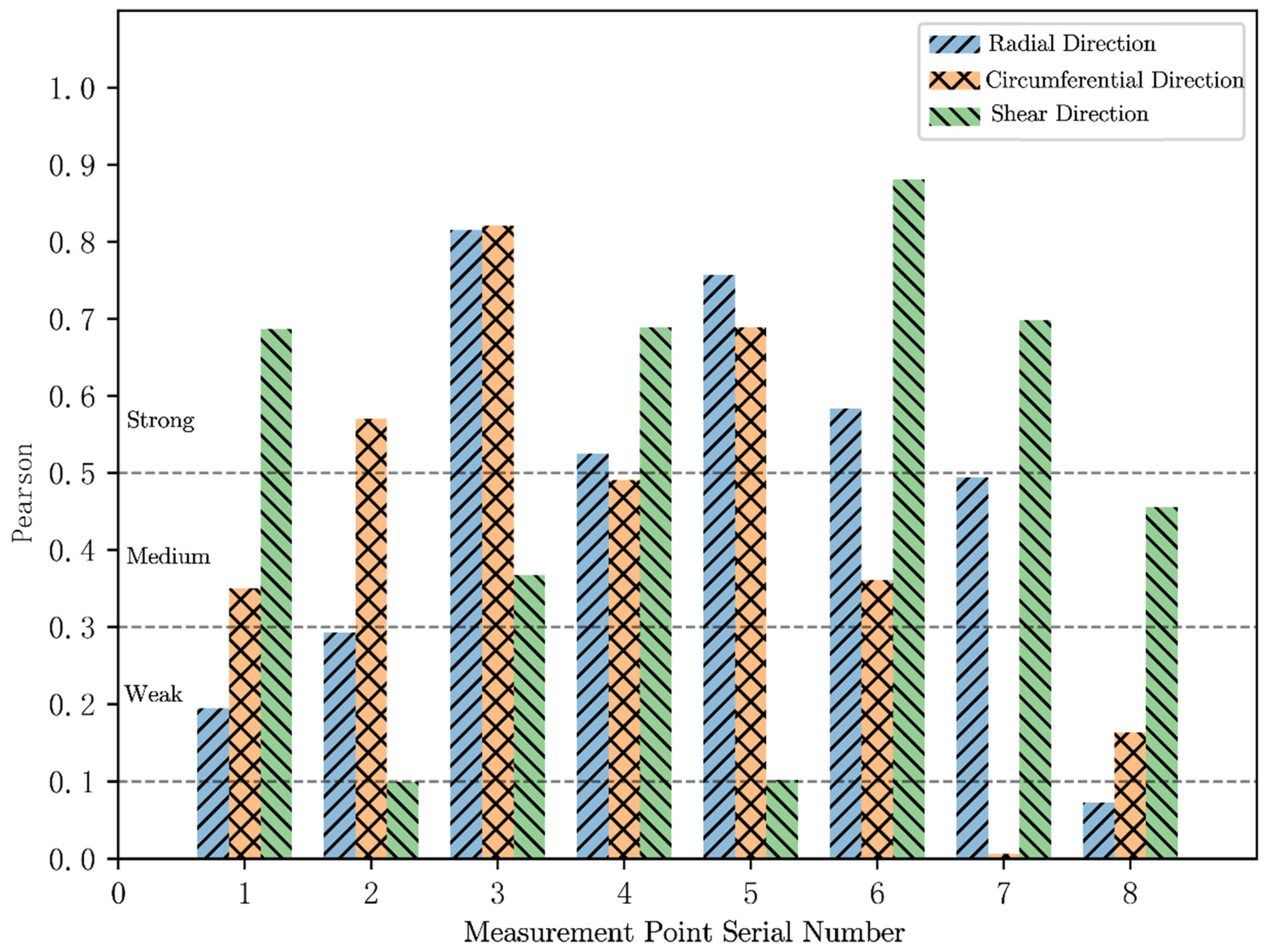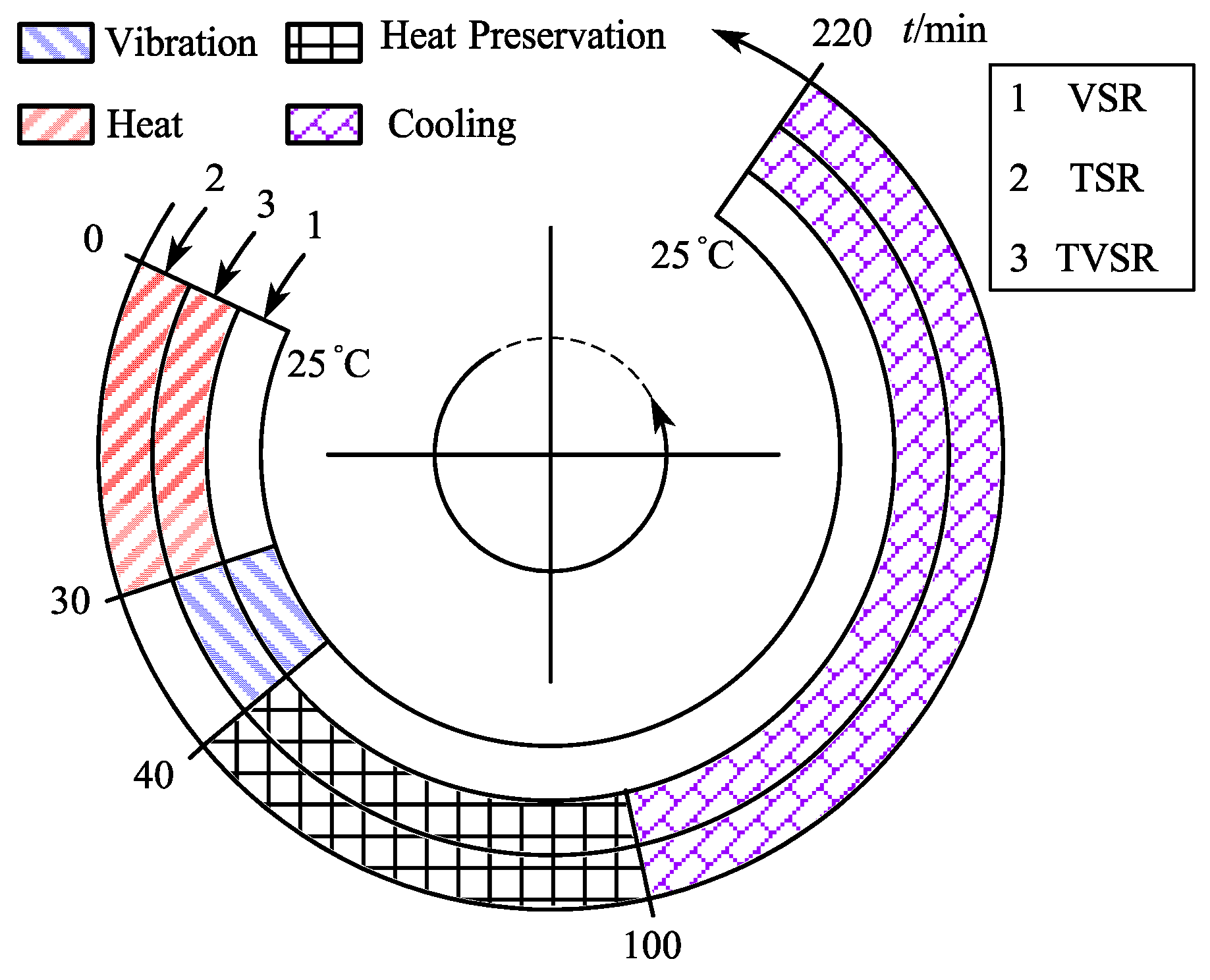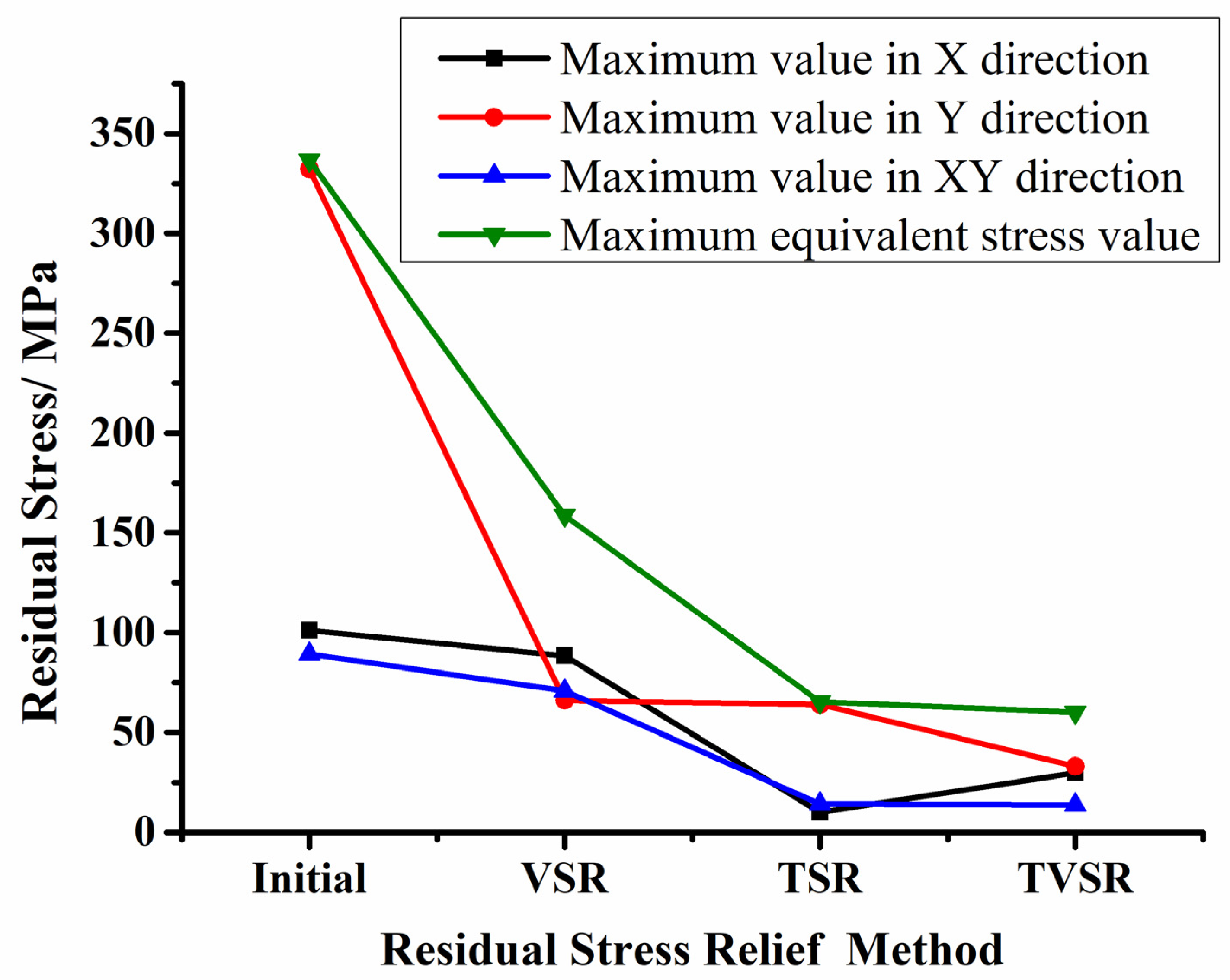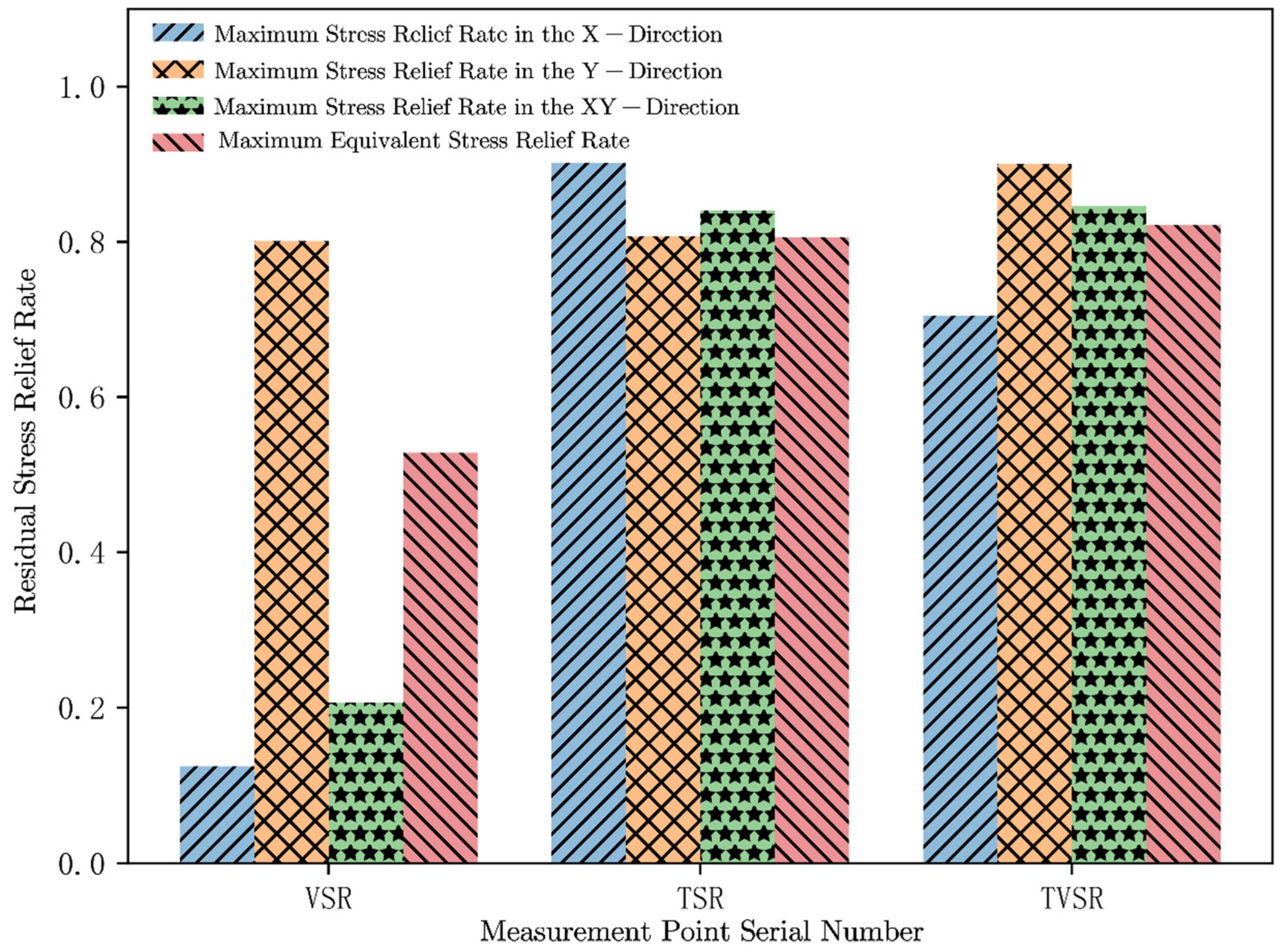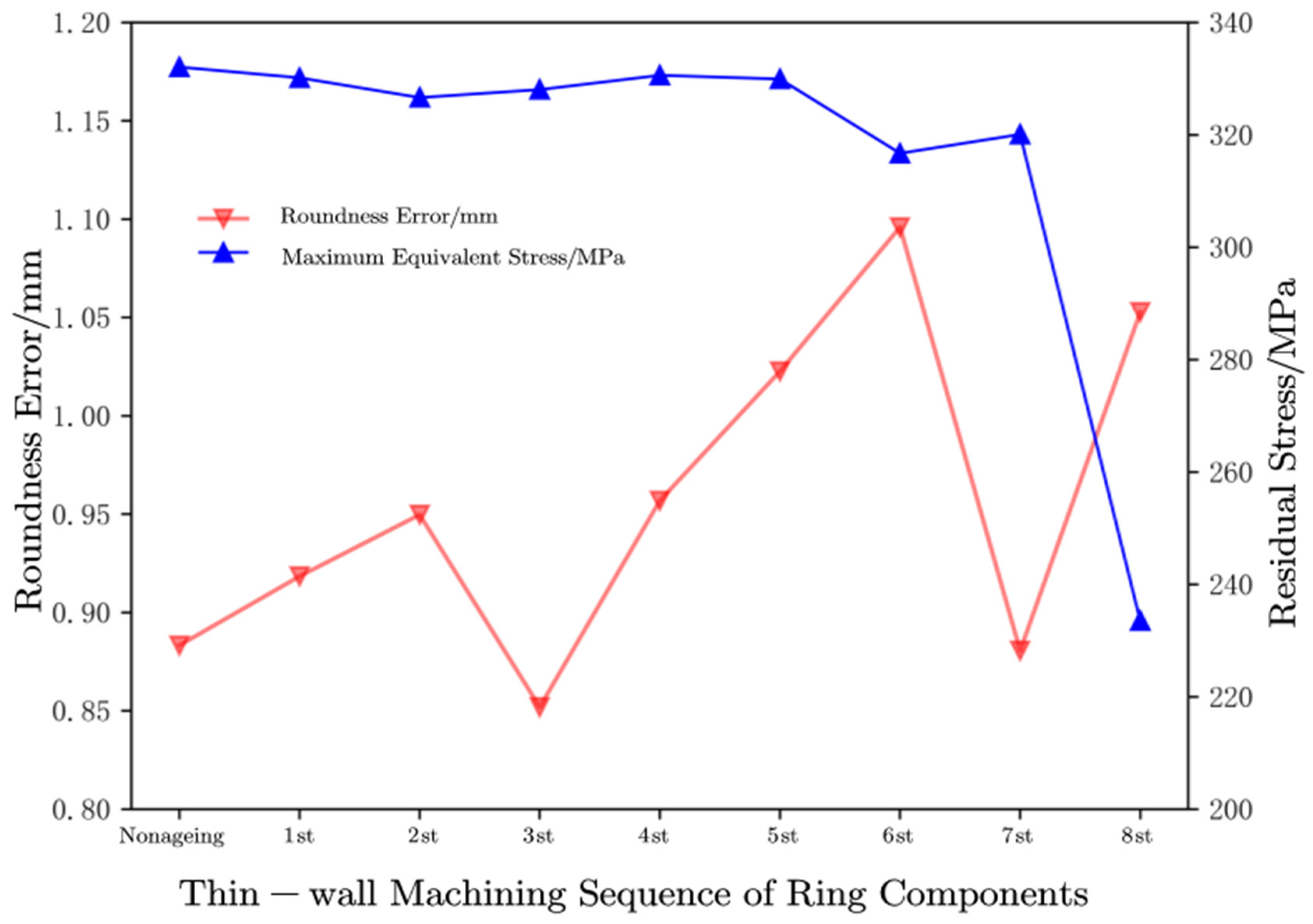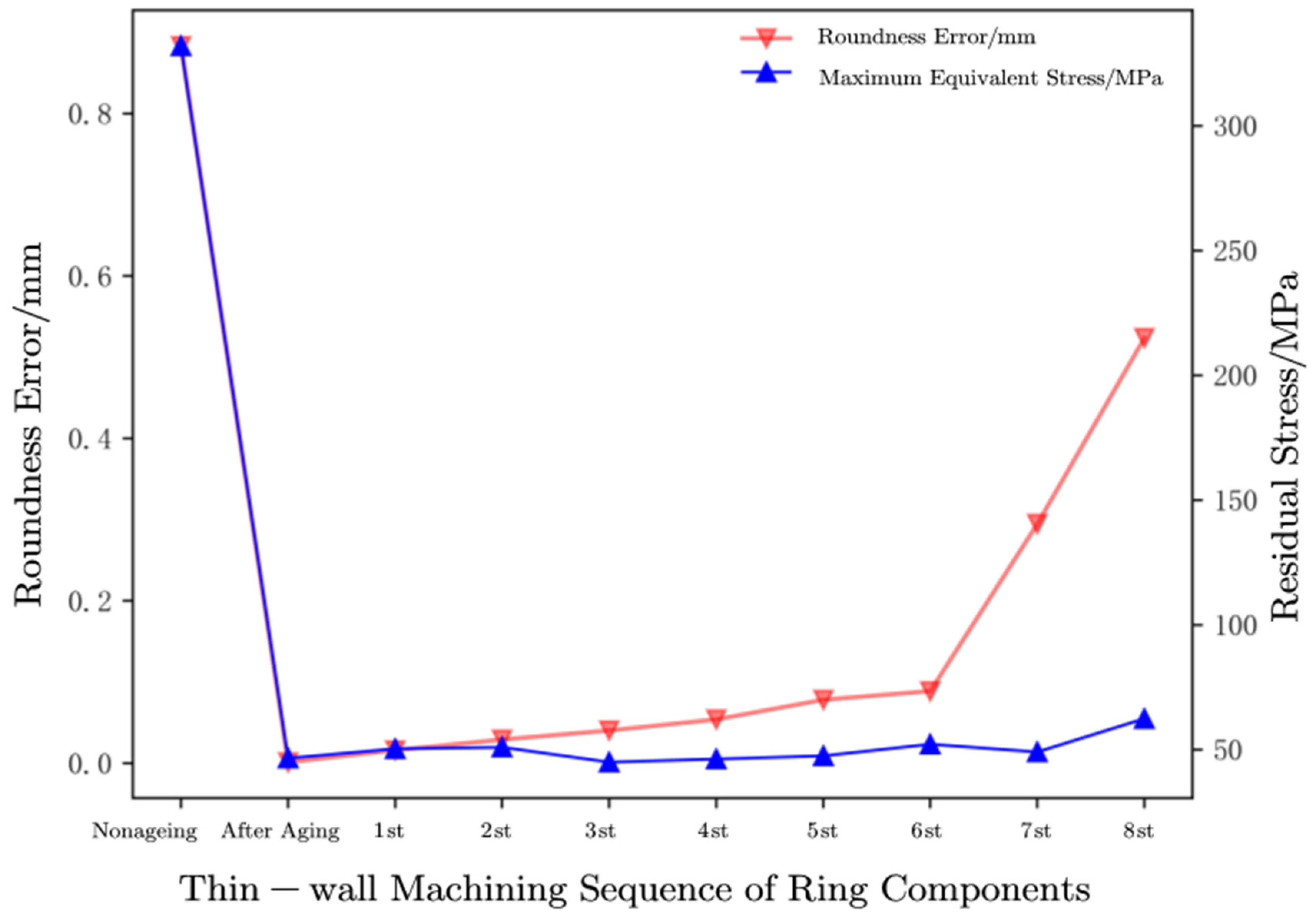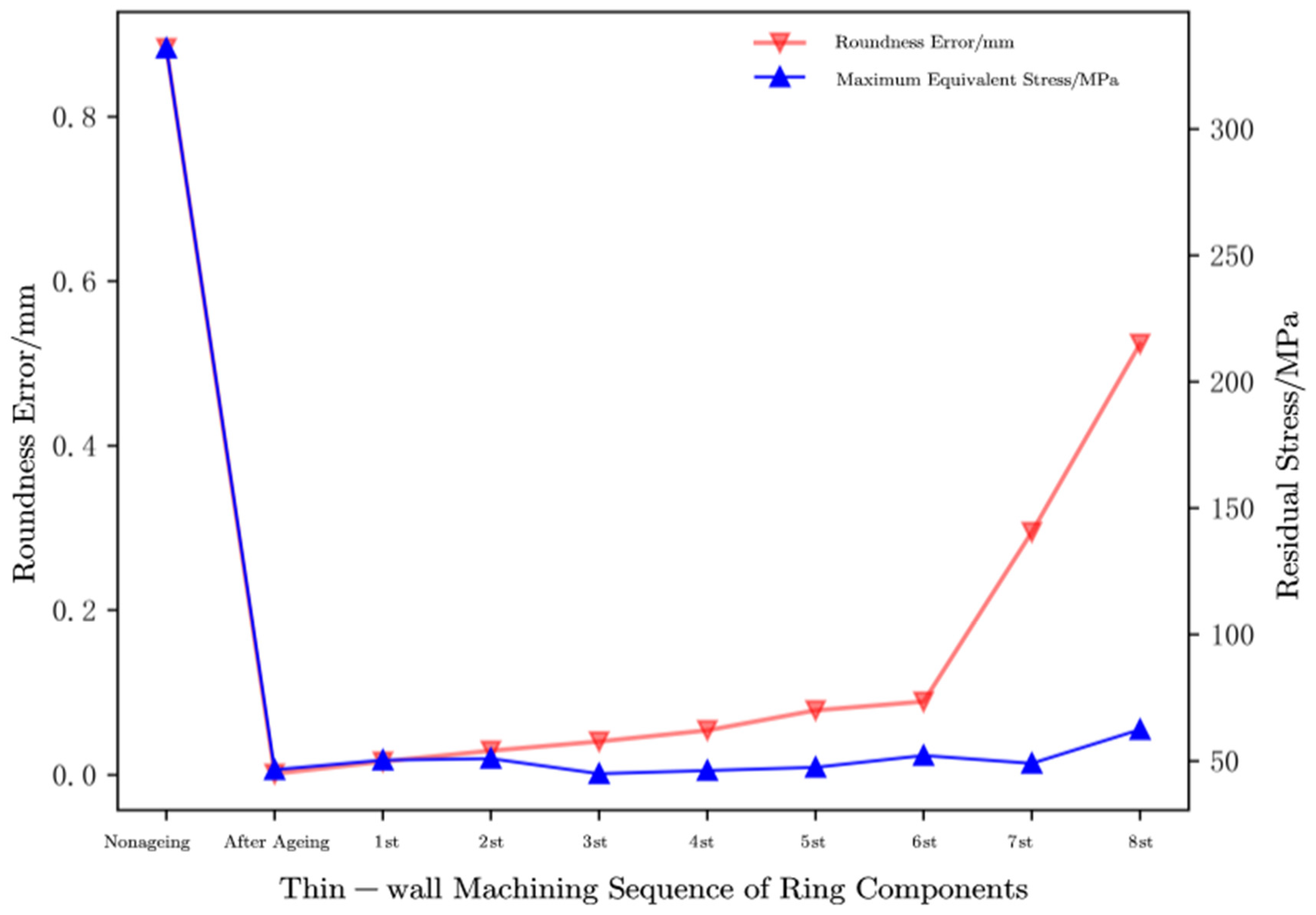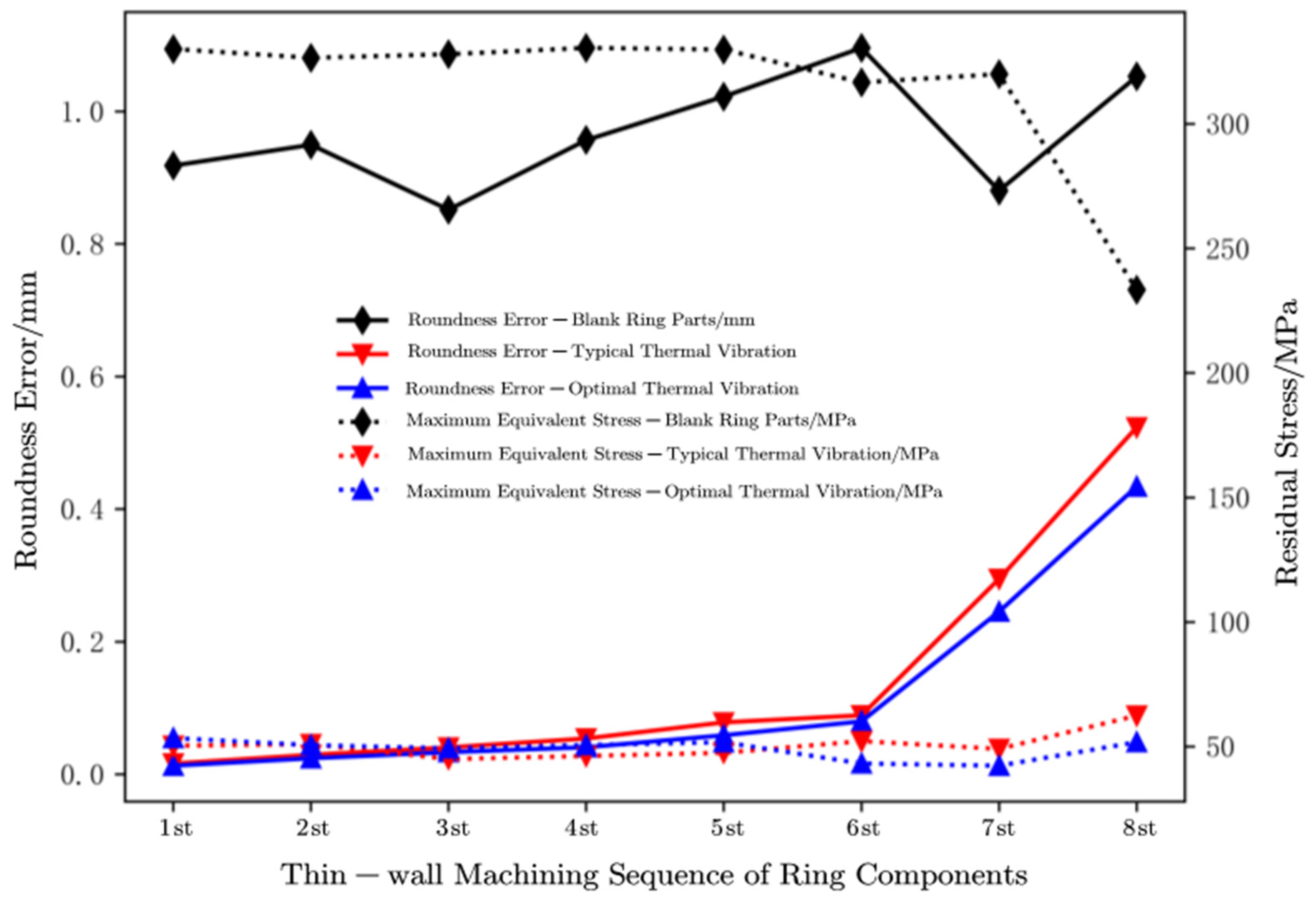1. Introduction
During processes such as machining, heat treatment, and electroplating, parts can directly or indirectly introduce residual stress. Residual stress exists in various machining processes of the ring, and the excessive and unevenly distributed residual stress inside the ring may be an important factor in component failure and scrapping, especially when the ring is thin-walled cutting and forming process, as well as when the formed ring is subjected to large loads, complex external vibration environment, and intense high-temperature friction heat generation environment during rocket launch, residual stress becomes a factor that cannot be ignored.
Aluminum alloy ring rolling forming involves material nonlinearity and boundary conditions (such as temperature and load) nonlinearity. Under the coupling of temperature and processing environment, residual stress is inevitably generated. With the increase of ring rolling size, the uneven distribution of residual stress and local stress are more obvious. In addition, after ring rolling forming, the quality of the connecting ring used for rocket storage tanks is required, and it needs to be processed into an aviation thin-walled ring, which is prone to deformation during the manufacturing process. Residual stress not only reduces the ability of aluminum alloy to resist stress corrosion cracking, but also significantly reduces its strength, stability and fatigue resistance. Moreover, various research results show that the main factor causing machining deformation is the initial residual stress in the blank, which has the greatest impact on machining deformation [
1,
2,
3]. With the continuous thinning of rough forgings, the initial residual stress is released and redistributed, resulting in deformation during the processing and use of parts, low forming accuracy, and noncircular shapes. Therefore, in order to effectively control and reduce the structural deformation that occurs during the use of 2219 aluminum alloy rings, it is necessary to minimize the residual stress in the blank ring forging as much as possible. In addition, in response to the deformation caused by out of roundness during the use of rough ring forgings, it is also necessary to ensure that the residual stress in the rough ring forgings is evenly distributed along the circumference as much as possible.
Integral thin-walled parts are widely used in aviation and aerospace production due to their high specific stiffness and strength. The largest integral rolling ring has a diameter of nearly 10 meters and a wall thickness of about 0.2 meters. When processing large thin-walled rolling ring parts, they are prone to machining deformation caused by residual stress [
4]. In addition, thin-walled parts are manufactured through turning and milling, in which more than 90% of the material is removed from the billet. The appropriate distribution of residual stress can significantly reduce machining deformation [
5]. Therefore, as the main blank forging of aviation storage tank parts, the removal of residual stress in 2219 aluminum alloy rings is an important link to ensure the dimensional stability of the parts, improve the assembly accuracy, performance, and reliability of the storage tank [
6]. The homogenization of initial residual stress has become more important for solving machining deformation.
At present, the method of reducing or eliminating residual internal stress in metal at home and abroad to stabilize the dimensional accuracy of metal workpieces is called "aging". The use of aging technology is the most common method for controlling residual stress. In the ring rolling process, the blank forming process inevitably generates high and uneven residual stress. Research by experts [
7] suggests that the decrease in peak residual stress changes the internal stress field, causing the internal stress of the component to decrease and redistribute, achieving equilibrium at lower stress levels. Therefore, after the ring blank forming process, aging techniques (such as natural aging, TSR, VSR, and TVSR) are generally used to eliminate or reduce the adverse effects of residual stress on the workpiece. The basic idea of either method is to intervene in the micro defects or dislocation of lattice molecules within metal components, enabling them to undergo plastic deformation or lattice movement at the micro level, eliminating the imbalanced dislocation caused by such lattice molecules, and thereby reducing or eliminating internal stress [
8].
The natural aging method utilizes the "slow release" characteristic of residual stress inside the workpiece over a sufficiently long period of time. Although this method is simple and easy to implement, with high and stable dimensional accuracy, it has a long cycle and low efficiency, and is no longer sufficient to meet the needs of modern production. Under the modern industrial system, it has been basically phased out.
The thermal stress relief (TSR) method, which eliminates or reduces residual stress due to the elastic-plastic deformation caused by the thermal relaxation effect under temperature, is relatively reliable and the process is relatively mature. Research has shown that different aging heat treatments will have a significant impact on the final properties of alloy materials [
9]. Researchers from various countries have analyzed various TSR processes for aluminum alloy parts, and found that TSR at the aging temperature of aluminum alloy can not only ensure the performance of the parts does not decrease, but also meet the requirement that the residual stress level is at a lower level, which is better than natural aging. This ensures the reliability of the parts and improves their lifespan, and makes the mechanical properties of the materials better [10, 11]. In recent years, researchers from various countries have continuously explored the mechanism of TSR. Some researchers [
12] believe that most aluminum alloy components undergo aging treatment after quenching, and the residual stress of the components changes due to material creep during this process. Therefore, on the basis of quenching stress research, Gao et al. [
13] have extended the study of residual stress evolution to the aging stage based on creep behavior research. Dong et al. [
14] studied the evolution behavior of quenching residual stress in 2024 aluminum alloy during aging. This study showed that the quenching residual stress of components gradually decreases with time when aged at 140~170 ℃. With the rapid development of science and technology and in-depth research on TSR technology, the theory of creep behavior can better describe the residual stress process of parts controlled by TSR technology.
Vibration stress relief (VSR) is an energy saving, environmentally friendly, and efficient stress relief process. The ordinary vibration generated by mechanical and other methods (such as vibration exciters) repeatedly applies cyclic loads to the workpiece with residual stress, causing a certain plastic deformation of the workpiece. As a result, the residual stress is relaxed and reduced, thereby stabilizing the size of the workpiece. VSR is a supplement and development of TSR, replacing TSR within a certain range [15, 16]. Many researchers [17-21] have studied the VSR during part resonance through experimental or numerical analysis. The larger amplitude generated by excitation can more effectively eliminate residual stress. In engineering, excitation at zero amplitude can be used to meet the requirements of relatively small vibration intensity and good stress relaxation. This technology is almost applicable to all types of part shapes and sizes, whether it is thin-walled parts, welded parts, or square plates, this technology can improve the dimensional stability of parts, and the residual stress distribution is more uniform after VSR treatment.
Thermal-vibration stress relief (TVSR), as the temperature increases to the aging temperature, the elastic modulus of the material decreases, which not only helps to increase the amplitude but also reduces the yield strength. Dynamic stress is generated at the natural frequency of the part and under external vibration loads, resulting in greater yield and relaxation of residual stress. The residual stress homogenization method first proposed by Zhang et al. [
22] achieves residual stress relief under lower strain conditions under the combined action of high temperature and vibration. Improved delamination method experiments and numerical simulations were used to verify that the stress homogenization effect of TVSR on 7075 aluminum alloy is better than that of VSR. TVSR technology is a new research direction on workpiece aging technology in recent years. As a new type of stress homogenization process, TVSR is gradually receiving attention from scholars. Gao et al. [
23] studied the residual stress and microstructure differences of Ti6Al4V titanium alloy under three different aging techniques: TSR, VSR, and TVSR. The results showed that TVSR and TSR were able to eliminate more than 90% of residual stress, but the removal efficiency of TVSR was 4.2 times that of TSR; Meanwhile, the elimination efficiency of TVSR is 45.04% higher than that of VSR. Chen et al. [
24] studied three aging techniques: TSR, VSR, and TVSR, and compared the residual stress homogenization effect of 2219 aluminum alloy welded parts. The results showed that after the three aging treatments, the stress of 2219 aluminum alloy welded samples was relatively small and uniform, and TVSR performed better in overall homogenization of stress at the weld seam. Li et al. [
25] studied the TVSR process on the control of the residual stress and machining deformation before finish machining. It can be concluded that the final maximum deformation of specimen can be reduced by 38.33%. Kasim et al. [
26] combined VSR and heat treatment after welding, and found that the resonance frequency and higher vibration amplitude of VSR are more effective for stress homogenization after welding heat treatment. Chen et al. [
27] optimized the TVSR process based on aluminum alloy rings by studying the effects of different amplitudes, vibration times, vibration frequencies, heating times, holding times, and cooling times on TVSR treatment. The results show that the optimized process parameters can reduce the maximum residual stress of the aluminum alloy ring by 93.6%.
TVSR can significantly eliminate residual stress inside aluminum alloys and effectively reduce the residual stress of 7075 aluminum alloy. Due to the unique shape of ring shaped parts during quenching, residual stress is introduced into the 2219 aluminum alloy ring during the quenching experiment, resulting in a complex distribution of residual stress field. During multiple stages of heating, insulation, and rapid cooling, the radial stress, circumferential stress, and shear stress inside the ring are constantly changing.
Therefore, in order to study the homogenization and regulation of residual stress inside the 2219 aluminum alloy ring of the new generation rocket storage tank by VSR, TSR, and TVSR. In response to the problem of large and uneven distribution of residual stress inside the ring, stress aging homogenization and regulation research were conducted on 2219 aluminum alloy ring after obtaining the initial residual stress. By establishing a finite element numerical model of the ring component and assigning initial residual stress during quenching, the numerical simulation results of TVSR technology, VSR technology, and TSR technology are used to verify the homogenization and control effect of residual stress inside the aluminum alloy ring component before and after the process. Then, numerical simulation technology was used to study how the initial residual stress in the blank during the thin-walled machining process of the ring will cause the deformation of the ring, and the deformation law of the thin-walled machining of the ring was studied.
4. Conclusion
This paper takes 2219 aluminum alloy rings as the research object, combines constitutive theories related to TSR and VSR, and establishes a finite element model using ANSYS numerical simulation software. In order to explore the effect of stress aging technology on the regulation and homogenization of residual stress inside the ring, the initial stress of the ring blank was measured using drilling method experiments. At the same time, the creep constitutive coefficient of 2219 aluminum alloy was determined through stress relaxation experiments, and the numerical simulation calculation processes of VSR, TSR, and TVSR were compared and established. The simulation results show that VSR, TSR, and TVSR can homogenize and reduce the residual stress field inside the ring, improve the distribution of residual stress inside the ring, and achieve a homogenization control effect of TVSR>TSR>VSR. The TVSR method is an optimal method for eliminating and homogenizing residual stress in the ring. Then, using numerical simulation technology to study how the initial residual stress in the blank will cause the deformation of the ring during thin-walled machining process. The minimum inclusion zone method roundness error theory is applied to evaluate the deformation degree during thin-walled numerical machining process, and the TVSR method is used for stress regulation. The deformation law of thin-walled machining of the ring under different aging parameters is studied. The conclusion of this simulation result is as follows:
(1) Based on the creep mechanism of TSR and the principle of VSR, this paper conducted a simulation of residual stress control of 2219 aluminum alloy rings during TVSR using ANSYS. The simulation results show that the derived constitutive model can describe the stress relaxation process of TVSR by combining a single thermal time effect stress relaxation constitutive theory with a VSR plastic deformation material model.
(2) Analyze the correlation between the experimental measurement results of initial residual stress and the established numerical simulation results of the ring containing initial residual stress. It can be seen that the strong correlation in three directions of each measurement point accounts for over 37.5%, and the moderate correlation accounts for over 62.5%. Compared with the numerical simulation model, the measurement values of residual stress in the overall experiment of 2219 aluminum alloy ring show a moderate and strong correlation with the initial residual stress in three directions. This indicates that the numerical simulation model of 2219 aluminum alloy ring containing initial residual stress can accurately reflect the size and distribution of residual stress inside the actual ring.
(3) VSR, TSR, and TVSR can all regulate and reduce the residual stress of 2219 aluminum alloy rings. The VSR homogenization rate is the smallest, and the radial direction of the ring is only 12.5%. The maximum equivalent residual stress relief rate of ring TSR and TVSR can reach over 80%, and the residual stress relief effect of ring components is very effective after aging. The VSR control has a certain effect on reducing and homogenizing the residual stress of 2219 aluminum alloy rings, but compared with TSR and TVSR, the residual stress control reduction and homogenization ability are limited.
(4) VSR, TSR, and TVSR can all homogenize residual stresses inside and on the surface of the ring, and the overall homogenization ability of TVSR is good. Regardless of whether the residual stress inside the ring is large or small, the maximum equivalent stress homogenization rate for all three aging treatments is at least 40%. But when the residual stress is large, the TVSR is more effective in homogenizing the stress of the ring, and the maximum stress homogenization rate in the circumferential direction can reach 90.0%. The maximum equivalent stress homogenization rates of VSR, TSR, and TVSR are 52.8%, 80.6%, and 82.2%, respectively. It can be seen that the effect of homogenization and regulation of residual stress inside the 2219 aluminum alloy ring is more effective for TVSR than VSR and TSR.
(5) Different TVSR parameters can cause different residual stress homogenization effects inside the ring. Among them, compared with the results before aging, the optimal thermal vibration parameters have a decrease amplitude rate of 84.4% in the maximum equivalent stress after aging, and a decrease rate of 50.8% in roundness error; The maximum equivalent stress reduction amplitude rate of typical thermal vibration parameters after aging is 81.2%, and the roundness error reduction rate is 40.7%. The optimal thermal vibration parameters of the thin-walled machining numerical model have better aging effect. It can be seen that appropriate TVSR parameters are the key to homogenizing the residual stress inside the ring and improving the machining deformation accuracy. The optimal thermal vibration parameters have a better effect on controlling the deformation of thin-walled processing of ring components than typical thermal vibration parameters.
(6) The deformation degree of thin-walled ring components with a "r" shaped cross-section will increase in the final processing stage (7th and 8th times in this article). Under the optimal thermal vibration parameters, the roundness error in the 7th and 8th processing stages increased from 0.0798 mm to 0.2454 mm and 0.4341 mm, respectively, compared to the 6th processing stage, with an increase rate of 207.4% and 443.9%, respectively. Under typical thermal vibration parameters, the roundness error in the 7th and 8th processing stages increased from 0.0889 mm to 0.2948 mm and 0.5236 mm compared to the 6th processing stage, with an increase rate of 231.4% and 488.6%, respectively. Therefore, in the final stage of thin-walled ring processing and forming, the processing process plan should be adjusted to improve the accuracy of thin-walled ring processing and forming after TVSR.
Figure 1.
ring quenching process.
Figure 1.
ring quenching process.
Figure 2.
residual stress measurement. a) System of measuring residual stress of ring by hole-drilling method, b) Experimental clamping scheme for 2219 aluminum alloy ring.
Figure 2.
residual stress measurement. a) System of measuring residual stress of ring by hole-drilling method, b) Experimental clamping scheme for 2219 aluminum alloy ring.
Figure 3.
Equilibrium of micro-element.
Figure 3.
Equilibrium of micro-element.
Figure 4.
Fitting diagram of four groups of 7075-T6 aluminum alloy stress relaxation curve.
Figure 4.
Fitting diagram of four groups of 7075-T6 aluminum alloy stress relaxation curve.
Figure 5.
Numerical simulation process of thermal-vibration stress relief for 2219 aluminum alloy ring.
Figure 5.
Numerical simulation process of thermal-vibration stress relief for 2219 aluminum alloy ring.
Figure 6.
Thin-walled ring a) machining shapes of rings, b) processing sequence of thin-walled ring.
Figure 6.
Thin-walled ring a) machining shapes of rings, b) processing sequence of thin-walled ring.
Figure 7.
Cross-section grid of rings.
Figure 7.
Cross-section grid of rings.
Figure 8.
Schematic diagram of coordinate measurement in ring machining process.
Figure 8.
Schematic diagram of coordinate measurement in ring machining process.
Figure 9.
Correlation analysis between experimental measurement and numerical simulation results of initial residual stress.
Figure 9.
Correlation analysis between experimental measurement and numerical simulation results of initial residual stress.
Figure 10.
Numerical simulation process for stress relief of 2219 aluminum alloy ring.
Figure 10.
Numerical simulation process for stress relief of 2219 aluminum alloy ring.
Figure 11.
Residual stress of 2219 aluminum alloy ring before and after stress relief.
Figure 11.
Residual stress of 2219 aluminum alloy ring before and after stress relief.
Figure 12.
Residual stress homogenization rate of 2219 aluminum alloy ring after stress relief.
Figure 12.
Residual stress homogenization rate of 2219 aluminum alloy ring after stress relief.
Figure 13.
Roundness error and maximum equivalent stress in thin-walled blank ring machining.
Figure 13.
Roundness error and maximum equivalent stress in thin-walled blank ring machining.
Figure 14.
Roundness error and maximum equivalent stress in thin-wall machining of ring parts.
Figure 14.
Roundness error and maximum equivalent stress in thin-wall machining of ring parts.
Figure 15.
Roundness error and maximum equivalent stress in thin-wall machining of ring parts.
Figure 15.
Roundness error and maximum equivalent stress in thin-wall machining of ring parts.
Figure 16.
Comparison results of roundness error and maximum equivalent stress in different machining processes.
Figure 16.
Comparison results of roundness error and maximum equivalent stress in different machining processes.
Table 1.
Curve fitting results of stress relaxation of 2219 aluminum alloy.
Table 1.
Curve fitting results of stress relaxation of 2219 aluminum alloy.
| Stress level /MPa |
Iterations |
Parameter |
|
σ∞
|
a1
|
b1
|
a2
|
b2
|
a3
|
b3
|
| 50 |
99 |
15.859 |
13.841 |
55.640 |
12.801 |
55.641 |
7.487 |
0.832 |
| 150 |
208 |
220.261 |
-23.666 |
-100.164 |
-23.669 |
-100.164 |
-23.667 |
-100.164 |
| 250 |
87 |
202.553 |
5.541 |
0.263 |
40.062 |
23.894 |
10.292 |
0.045 |
| 350 |
68 |
154.149 |
1096.787 |
0.022 |
160.053 |
31.214 |
- |
- |
Table 2.
Creep parameters of 2219 aluminum alloy.
Table 2.
Creep parameters of 2219 aluminum alloy.
| Creep Parameters |
C1
|
C2
|
C3
|
C4
|
| Solution Results |
1.1518E-12 |
3.40 |
-0.14 |
409.75 |
Table 3.
2219 aluminum alloy chemical composition table.
Table 3.
2219 aluminum alloy chemical composition table.
| Component |
Cu |
Fe |
Mn |
Si |
Zn |
Zr |
Ti |
V |
Al |
|
ωt% |
5.5-6.8 |
0.3 |
0.2-0.4 |
0.2 |
0.1 |
0.1-0.25 |
0.02-0.1 |
0.05-0.15 |
the rest |
Table 4.
Roundness error evaluation results of thin-walled blank ring machining.
Table 4.
Roundness error evaluation results of thin-walled blank ring machining.
| Machining Sequences |
Fitted Concentric Circle Center |
|
Fitted Concentric Circle Radius |
Roundness Error /mm |
| X/mm |
Y/mm |
|
Inside Diameter /mm |
Outside Diameter /mm |
| After Aging |
0.7912 |
-0.2892 |
|
182.6999 |
183.5832 |
0.8833 |
| 1st |
0.8262 |
-0.3017 |
|
189.6878 |
190.6062 |
0.91841 |
| 2st |
0.8602 |
-0.3115 |
|
196.6782 |
197.6279 |
0.9497 |
| 3st |
0.8832 |
-0.2829 |
|
201.7049 |
202.5568 |
0.8519 |
| 4st |
0.8594 |
-0.3251 |
|
201.6824 |
202.6393 |
0.9569 |
| 5st |
0.8440 |
-0.3493 |
|
201.6651 |
202.6877 |
1.0226 |
| 6st |
0.9699 |
-0.0901 |
|
201.6085 |
202.7045 |
1.0959 |
| 7st |
0.8169 |
0.1903 |
|
201.7445 |
202.6252 |
0.8806 |
| 8st |
0.6648 |
0.3158 |
|
201.5538 |
202.6066 |
1.0527 |
Table 5.
Maximum equivalent stress results of thin-walled blank ring machining.
Table 5.
Maximum equivalent stress results of thin-walled blank ring machining.
| Machining Sequences |
Nonageing |
1st |
2st |
3st |
4st |
5st |
6st |
7st |
8st |
| Maximum Equivalent Stress /MPa |
332.06 |
330.15 |
326.63 |
328.05 |
330.59 |
329.94 |
316.72 |
320.08 |
233.49 |
Table 6.
Typical thermal-vibration parameters.
Table 6.
Typical thermal-vibration parameters.
| Vibration Amplitude ratio |
Vibrating Time /min |
Vibration Frequency /Hz |
Heating Time /h |
Holding Time /h |
Cooling Time /h |
| 1 |
2 |
619.096 |
0.5 |
1 |
1 |
Table 7.
Roundness error evaluation results of ring thin-walled machining.
Table 7.
Roundness error evaluation results of ring thin-walled machining.
| Machining Sequences |
Fitted Concentric Circle Center |
Fitted Concentric Circle Radius |
Roundness Error /mm |
| X/mm |
Y/mm |
Inside Diameter /mm |
Outside Diameter /mm |
| After Aging |
-0.1323 |
-0.0002 |
182.9993 |
183.0007 |
0.0014 |
| 1st |
-0.1291 |
-0.0027 |
189.9919 |
190.0081 |
0.0162 |
| 2st |
-0.1291 |
-0.0074 |
196.9884 |
197.0177 |
0.0293 |
| 3st |
-0.1238 |
-0.0071 |
201.9820 |
202.0225 |
0.0405 |
| 4st |
-0.1238 |
-0.0091 |
201.9815 |
202.0355 |
0.0540 |
| 5st |
-0.1096 |
-0.0086 |
201.9697 |
202.0480 |
0.0783 |
| 6st |
-0.1274 |
0.0154 |
201.9561 |
202.0450 |
0.0889 |
| 7st |
-0.1351 |
0.05043 |
201.8588 |
202.1536 |
0.2948 |
| 8st |
-0.1284 |
0.11065 |
201.7239 |
202.2475 |
0.5236 |
Table 8.
Maximum equivalent stress in thin-wall machining of ring parts.
Table 8.
Maximum equivalent stress in thin-wall machining of ring parts.
| Machining Sequences |
After Aging |
1st |
2st |
3st |
4st |
5st |
6st |
7st |
8st |
| Maximum Equivalent Stress /MPa |
46.57 |
50.35 |
50.96 |
44.99 |
46.24 |
47.51 |
52.18 |
49.07 |
62.44 |
Table 9.
Optimum thermal-vibration parameters.
Table 9.
Optimum thermal-vibration parameters.
| Vibration Amplitude ratio |
Vibrating Time /min |
Vibration Frequency /Hz |
Heating Time /h |
Holding Time /h |
Cooling Time /h |
| 1 |
5 |
619.096 |
1 |
1.5 |
2 |
Table 10.
Roundness error evaluation results of ring thin-walled machining.
Table 10.
Roundness error evaluation results of ring thin-walled machining.
| Machining Sequence |
Fitted Concentric Circle Center |
Fitted Concentric Circle Radius |
Roundness Error /mm |
| X/mm |
Y/mm |
Inside Diameter /mm |
Outside Diameter /mm |
| After aging |
-0.1323 |
-0.0001 |
182.9994 |
183.0006 |
0.0013 |
| 1st |
-0.1299 |
-0.0019 |
189.9934 |
190.0063 |
0.0129 |
| 2st |
-0.1292 |
-0.0054 |
196.9900 |
197.0141 |
0.0241 |
| 3st |
-0.1244 |
-0.005 |
201.9851 |
202.0184 |
0.0333 |
| 4st |
-0.1259 |
-0.0062 |
201.9856 |
202.0263 |
0.0407 |
| 5st |
-0.1158 |
-0.0066 |
201.9775 |
202.0363 |
0.0589 |
| 6st |
-0.1274 |
0.0142 |
201.9604 |
202.0402 |
0.0798 |
| 7st |
-0.1353 |
0.0429 |
201.8817 |
202.1271 |
0.2454 |
| 8st |
-0.1269 |
0.0926 |
201.7694 |
202.2036 |
0.4342 |
Table 11.
Maximum equivalent stress in thin-wall machining of ring parts.
Table 11.
Maximum equivalent stress in thin-wall machining of ring parts.
| Machining Sequence |
After aging |
1st |
2st |
3st |
4st |
5st |
6st |
7st |
8st |
| Maximum Equivalent Stress/MPa |
55.36 |
53.41 |
50.59 |
49.30 |
50.61 |
51.75 |
43.22 |
42.32 |
51.77 |
